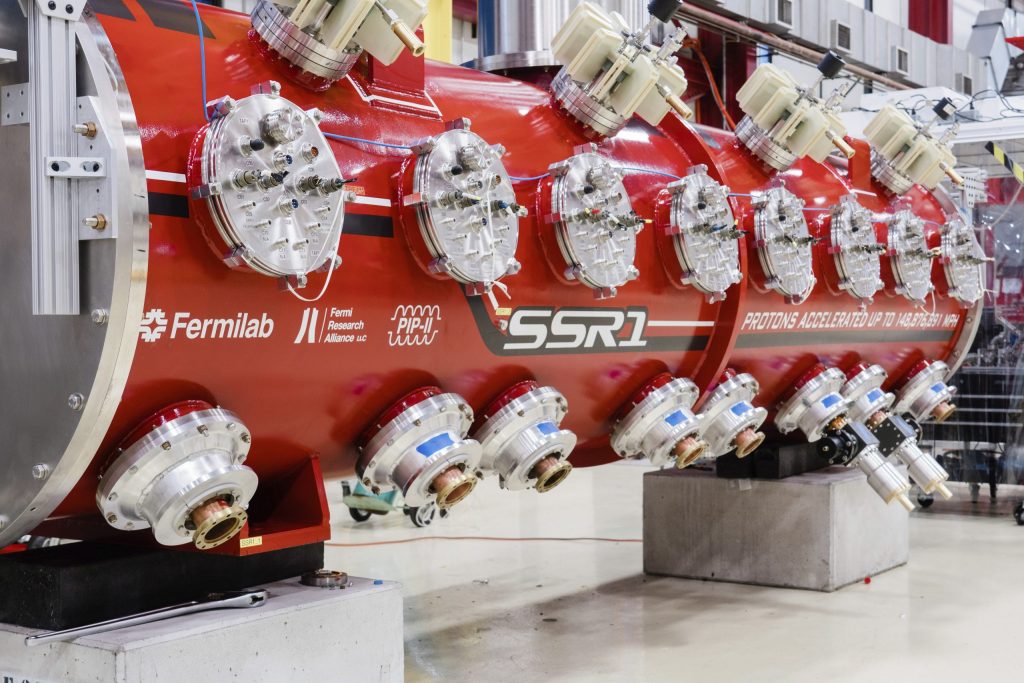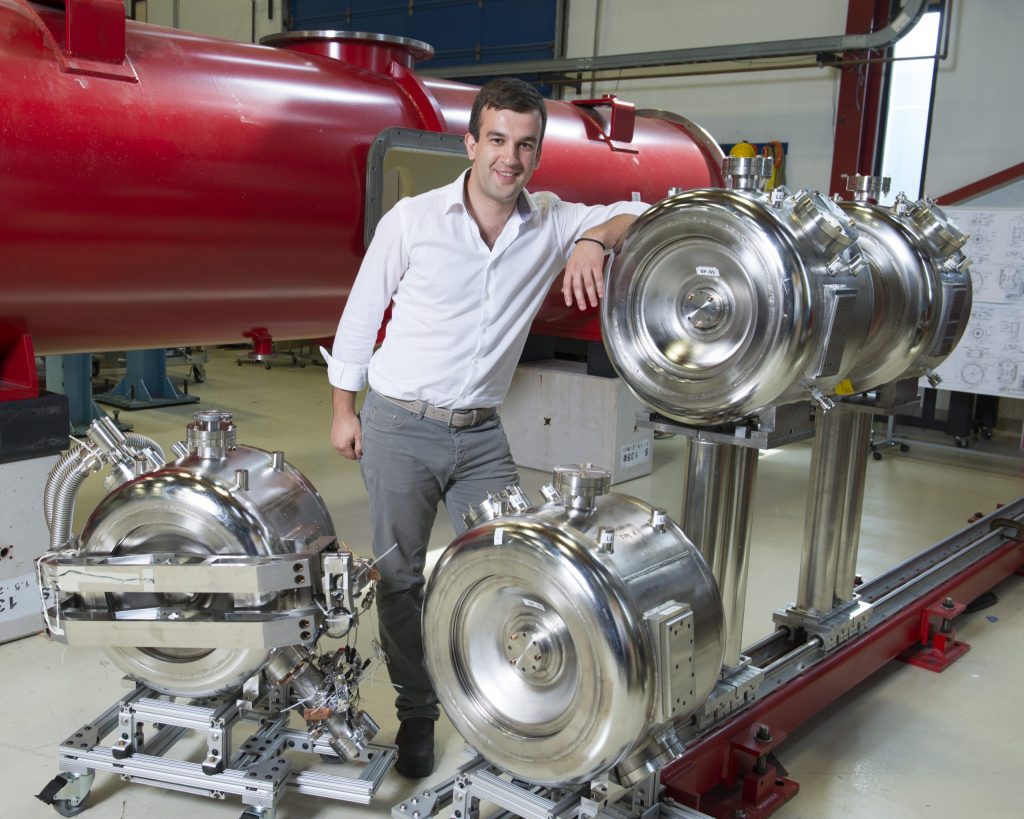In the next decade, a beam of neutrinos will travel at close to the speed of light from Illinois to South Dakota. The 800-mile trek will be powered by the world’s most intense proton beam created by the Proton Improvement Project-II, a particle accelerator project under construction at the Department of Energy’s Fermi National Accelerator Laboratory. PIP-II comprises an 800-million-electronvolt linear accelerator, known as the Linac. It will measure 215 meters in length and use superconducting radio frequency technology, the state-of-the-art technology used to accelerate particles to high energies.
Donato Passarelli’s contributions to the advancement of SRF technology over the past decade have earned him the inaugural Universities Research Association’s Engineering Award.

Donato Passarelli is the first recipient of the new URA Engineering Award, presented to him by URA President John Mester at the annual Users Meeting at Fermilab. Photo: Ryan Postel, Fermilab
“This achievement is the result of hard work from the past 10-plus years,” said Donato Passarelli, Fermilab principal engineer. “It is my privilege to contribute to the development of the PIP-II project, both as a team member and leader.”
It is the first URA honorary award to recognize an engineer at or in coordination with Fermilab in support of the lab’s mission.
“The URA Engineering Award recognizes the engineering talent necessary to advance science and our understanding of the world,” said URA President John Mester. “Donato Passarelli has been integral to forwarding PIP-II and the development of superconducting radio frequency technology.”
From intern to principal engineer
For Passarelli, his work on SRF technologies at Fermilab began as an intern while a graduate student at the University of Pisa. He joined the SRF Department in Fermilab’s Technical Division in 2010.
As an intern, Passarelli began work on the PIP-II project from its infancy. He initially helped with the mechanical design and optimization of the Single-Spoke Resonator 1 and tuner — a key piece of equipment used in the PIP-II Linac to accelerate the particle beam.
“When I joined as an intern, these SSR1 cavities were more or less a research and development activity,” Passarelli said. “I basically followed the development of this cavity and then its integration into a real project.”

The SSR1 cryomodule is one of five types of cryomodules that will propel particles in the PIP-II particle accelerator. Photo: Tom Nicol, Fermilab
His work on SSR1 inspired his doctorate thesis. While on track for his doctorate, Passarelli continued work alongside Fermilab’s Technical Division, designing the SSR1 cavity and cryomodule. In 2015, he successfully received his doctorate from the University of Pisa and continued to work on PIP-II. Over the next decade, Passarelli took on roles throughout the SRF department, ranging from guest engineer to principal engineer. He embraced new leadership roles, becoming SRF systems engineering group leader in Fermilab’s Applied Physics and Superconducting Technology Directorate, PIP-II Level 3 manager for single spoke cavities and cryomodules, and, most recently, the PIP-II Level 2 systems manager for SRF and cryogenics.
The first of its kind
The SSR1 cryomodule serves as one of five types of SRF cryomodules for PIP-II, used to efficiently accelerate the particle beam. Composed of eight superconducting cavities and four focusing magnets, SSR1 was the first cryomodule designed and built from scratch at Fermilab and only the second of its kind in the world to be constructed.
“It was the first of its kind made here in the U.S., and it’s specifically for PIP-II,” Passarelli said about SSR1.
When Passarelli and his team introduced the SSR1 cryomodule, it was a new class of SRF technology. After years of work, they successfully completed testing on the SSR1 prototype in January 2021.
Its success solidified the “Fermilab-style cryomodule,” which became the design standard for all future SRF cryomodules for the PIP-II Project.
“This was already conceptualized by Tom Nicol, who was my supervisor at the time,” Passarelli said about how he was introduced to the Fermilab-style cryomodule. “I and the team took the concept and finalized the design, then engaged in procurement, fabrication, assembly and, ultimately, the cold testing of the entire system at two Kelvin.”

Fermilab engineer Donato Passarelli poses with PIP-II single spoke resonator cavities for the SSR1 cryomodule in 2015. Photo: Reidar Hahn, Fermilab
The Fermilab style features unique elements such as the “strongback,” which provides a cold mass foundation for PIP-II cryomodules. This has set the standard layout for the other cryomodules of PIP-II, including the Single-Spoke Resonator 2 cryomodule, which is currently under production.
“Donato’s innovative work resulted in a breakthrough,” said Tug Arkan, Fermilab senior principal engineer and URA Engineering Award committee member. “He is one of the main contributors to the SRF field.”
Inspiring the next generation of engineers and scientists
Throughout the development of SSR1 and his time at Fermilab, Passarelli has also been committed to uplifting early career engineers and scientists through mentorship.
“I’m trying to take all that I have learned and pass it on to the new generation of this community,” he said.
Passarelli has supervised over twenty graduate and undergraduate engineering students since 2015 and facilitated student exchanges with domestic and international universities to come to Fermilab.
“Teamwork, social capital, connectivity, networking and outreach is definitely what it’s like working with Donato,” Arkan said.
His passion for teaching stems from Fermilab’s mission to educate the next generation of scientists and engineers as well as pass along the mentorship shown to him when he first joined Fermilab.
“It’s showcasing someone who is an advocate for the lab,” said Jamieson Olsen, Fermilab principal senior and award committee chair, about what the URA Engineering Award represents. “It’s someone who is also very active at giving back to the lab whether that’s through mentoring or supervising interns.”
Engineering for a better world
Passarelli first considered pursuing engineering in high school. He was drawn to its real-world applications, like space exploration, and its ability to allow ideas to become reality.
“Engineers are complimentary to scientists in pursuing the mission,” he said.
Working with SRF technologies, Passarelli and his engineering team recognized the importance of collaborating with scientists in achieving project milestones. He began to involve expertise not only from engineering but other fields such as material science in different aspects of his work, from building the cavities to accelerating the beam.
“SRF technologies are one of the areas where engineers and scientists are both needed,” Passarelli said.
Currently, Passarelli is overseeing the design and construction of the PIP-II SRF Linac, which includes 23 cryomodules; the PIP-II cryoplant; and the cryoplant and cryogenics distribution system. The project’s scope benefits from significant contributions from international research institutions in India, the United Kingdom, Italy, France, and Poland. His contributions have advanced the progress of PIP-II and, more widely, opened myriad research opportunities for Fermilab.
During his career, he hopes to make a positive impact on the world through the lens of engineering.
“Being in this environment for multiple years now, I want to leave a meaningful contribution to this field of engineering in SRF technology,” he said. “And as an engineer, to make the world a better place through advancing technology.”
Fermi National Accelerator Laboratory is supported by the Office of Science of the U.S. Department of Energy. The Office of Science is the single largest supporter of basic research in the physical sciences in the United States and is working to address some of the most pressing challenges of our time. For more information, please visit science.energy.gov.



